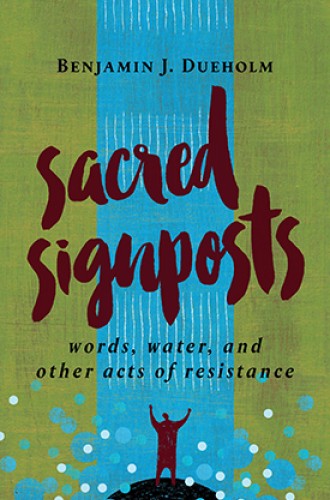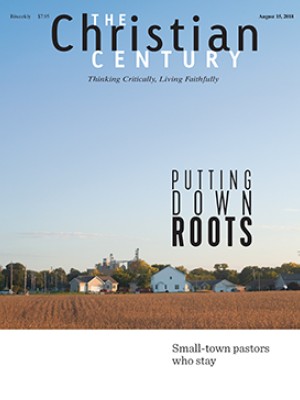The church's holy, subversive possessions
Ben Dueholm offers a humble apologetics—of faithful actions, not beliefs.
What does the church offer the world these days? The answer, in Benjamin Dueholm’s estimation, is what it has always offered: a sacred word, baptism, Eucharist, forgiveness, ministry, worship, and a cross-shaped lens through which to view it all. These are the “holy possessions” of the church. Each is an act of resistance in a world that tempts us to live as inhumane and godless people. These seven possessions are what we’ve got to work with and, according to Dueholm, it has always been so.
Sacred Signposts reads like Paul Woodruff’s Reverence, a collection of personal stories and deep ruminations on a topic that cannot be addressed head-on. A direct treatment would just be a collision. By writing about (or, more accurately, around) each practice, Dueholm reveals the shape, depth, and necessity of each. His writing is careful but not timid. Each chapter builds upon the previous one, culminating with the call to sacrificial living in “The Cross,” a topic which is both beautiful and biting, breaking readers open to the fragile power of the Christian life on which these practices leave their mark.
Read our latest issue or browse back issues.
Filled with wit and wisdom, honesty and humility, the book does what its subtitle suggests: it resists. It resists the temptation to be preachy and instead chooses a more poetic route. The subversive nature of our holy possessions can only be approached through subversive writing. Dueholm takes up that challenge, weaving the brilliance of Augustine and Bonhoeffer alongside that of his children, to reveal the meaning of Christian practices.
Dueholm posits that the practices of the church are more art than achievement, not mechanical movements of the faithful but actions that move the faithful. The church that seeks to engage the transcendent clings to these particular practices, and therefore these practices cling to us. Humanity’s search through the galaxies to find and take hold of charmed objects to bring good fortune and success is the dangerous underbelly of religious piety. Dueholm points out how each holy possession is the antithesis of that search, much to our surprise and benefit. The bread of the Eucharist may appear to be charmed in the hands of the priest, but it is the one who receives who ends up being charmed. The holy water turns the baptized, regardless of race, social status, or gender, into the holy one. The forgiven one is made clean without the opportunity to argue her case, which is an act of true grace. “This is the way of God,” each mark continually hammers home, “to turn the recipient into the blessing.”
Throughout it all, I found my own place in the conversation. How do the scriptures confront my reluctance to “give a damn” about my neighbor? How does baptism call me into community with those I disagree with? Dueholm’s twists and turns of phrase made me put the book down periodically to ponder my own relationship with each rite. A book about the ministry arts should do no less.
The unashamedly Lutheran hermeneutic at work here will not be a stumbling block for those who find themselves in other camps. One of Dueholm’s core convictions is that these practices are a golden thread that weaves through the church universal. I found this conviction a testament both to the strength of each practice and to their disruptive nature. Christians don’t appreciate having our sectarian tendencies challenged, and yet they are challenged in these marks of the church. The progressive Wesleyan and the paleo-Calvinist both find themselves under the sway of the same practices, though they might understand them differently. Dueholm makes this point with a grace and matter-of-factness that engender both humility and shock. It’s as if he’s naming a secret that we all know but refuse to acknowledge.
Sacred Signposts is hard to nail down within a genre. “Humble apologetics” might fit, although that description misses the mark, as does “spiritual memoir.” The book offers a humble apologetics not of the faith but of the faithful acts—and therefore of the practitioners, faithful or not. While the prose occasionally reads as romantic, it’s clear that Dueholm deeply loves these practices and feels loved by them, so his romanticism is easy to forgive. How else do you write about something you love?
I have often thought that, should my faith deteriorate into nothingness, the practices of the church would be what I would miss most, both in the doing and the receiving. Dueholm nods in agreement, and he notes that there is good reason for that. Intangible beliefs change, but these practices offer an enduring, tangible word for those seeking faith when all other words fail.
Our holy possessions continue to say something. It’s a mysterious but abiding something about the nature of God and humanity that gathers in the name of Christ. It’s something that the church has always offered to the world in roundabout ways, full of hope and resistance and grace.







